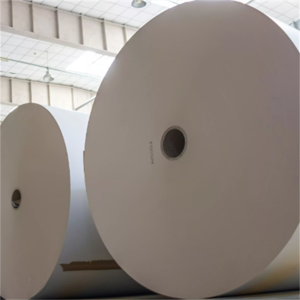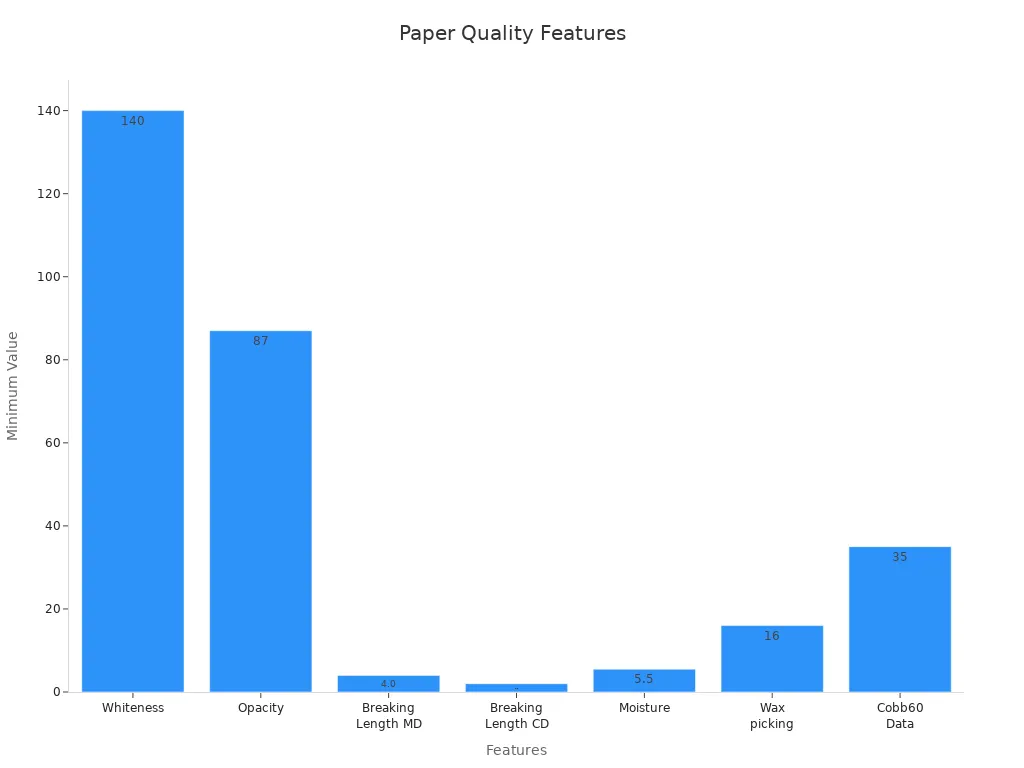
Books deserve paper that enhances every page. High whiteness offset paper customized size woodfree paper for book printing checks all the boxes. Its woodfree design ensures smooth, durable pages. Unlike C2s Coated Paper or Both Side Coated Art Paper, it reduces eye strain and offers exceptional readability. Bincheng’s option is a standout choice.
What is High Whiteness Offset Paper Customized Size Woodfree Paper for Book Printing?

High whiteness offset paper customized size woodfree paper for book printing is a premium material designed to elevate the quality of printed books. Its unique combination of high brightness, durability, and smooth texture makes it a favorite among publishers and educators. But what exactly sets it apart? Let’s dive into its key features and the meaning behind the term “woodfree.”
Key Features of High Whiteness Offset Paper
This paper stands out due to its technical specifications and performance. Here’s a quick overview of what makes it exceptional:
| Specification | Description |
|---|---|
| Whiteness | High, ensuring vibrant text and images |
| Type | Offset paper, ideal for book printing |
| Coating | Double-adhesive on both sides for uniform ink absorption |
| Characteristics | Low scalability, tight texture, good smoothness, and strong water resistance |
| Packaging | Available in roll packing or bulk sheets |
| Usage | Perfect for books, teaching materials, and other printed products |
Its high whiteness level (±5 at 140) ensures excellent readability, while its opacity (minimum 87%) prevents text from showing through on double-sided pages. The paper also boasts impressive durability, with a breaking length of 4.0 km (MD) and 2.0 km (CD). These features make it a reliable choice for high-speed rotary printing and long-lasting books.

Understanding the Term “Woodfree”
Despite its name, “woodfree” paper doesn’t mean it’s made without wood. Instead, it refers to the absence of mechanical wood pulp in its composition. This type of paper is crafted using chemical pulp, which removes lignin—a substance that causes paper to yellow over time. As a result, woodfree paper offers better durability and a smoother surface, making it ideal for high-quality book printing.
By choosing high whiteness offset paper customized size woodfree paper for book printing, publishers can ensure their books not only look great but also stand the test of time.
Benefits of High Whiteness Offset Paper for Book Printing

Enhanced Readability and Reduced Eye Strain
Readers spend hours flipping through pages, whether they’re immersed in a novel or studying for exams. High whiteness offset paper customized size woodfree paper for book printing makes this experience easier on the eyes. Its high brightness reflects light evenly, reducing glare and preventing eye fatigue. The smooth texture ensures that text appears crisp and clear, making it effortless to follow every word.
This paper’s opacity also plays a big role in readability. It prevents text from bleeding through to the other side of the page, even during double-sided printing. Readers can focus on the content without distractions, which is especially important for textbooks and educational materials.
Tip: Publishers looking to create books that readers can enjoy for hours should prioritize paper that minimizes eye strain. High whiteness offset paper is a smart choice for this reason.
Aesthetic Appeal for Text and Images
Books aren’t just about words; they’re visual experiences too. High whiteness offset paper customized size woodfree paper for book printing enhances the aesthetic appeal of both text and images. The paper’s natural brightness makes colors pop and ensures sharp contrasts, giving every page a polished look.
Images printed on this paper appear vibrant and lifelike. Whether it’s an art book showcasing intricate designs or a photography collection capturing vivid landscapes, this paper brings visuals to life. Even simple black-and-white text benefits from the paper’s smooth surface, which ensures uniform ink absorption and prevents smudging.
Readers often judge books by their appearance, and publishers know that presentation matters. High whiteness offset paper helps books stand out on shelves and in readers’ hands.
Durability and Resistance to Yellowing
Books are meant to last, whether they’re passed down through generations or stored on library shelves. High whiteness offset paper customized size woodfree paper for book printing excels in durability. Its chemical pulp composition removes lignin, the substance responsible for yellowing over time. This ensures that pages retain their original brightness and readability for years.
The paper’s tensile strength adds another layer of durability. It withstands the demands of high-speed rotary printing and post-press processing without tearing or losing its shape. This makes it ideal for large-scale production, where efficiency and quality go hand in hand.
Note: Books printed on durable paper not only look better but also hold up to frequent use. High whiteness offset paper ensures that every page remains intact and visually appealing.
Comparing High Whiteness Offset Paper to Other Paper Types
Advantages Over Coated Paper
When it comes to book printing, high whiteness offset paper outshines coated paper in several key areas. Coated paper, often used for magazines or glossy brochures, has a shiny surface that can make reading difficult. High whiteness offset paper, on the other hand, offers a matte finish that’s easier on the eyes. This makes it a better choice for books, where readability is a top priority.
Another major advantage lies in color accuracy. High whiteness offset paper ensures that colors appear vibrant and true to life. Coated paper, while decent, often struggles with maintaining consistent brightness and color accuracy. The difference becomes even more noticeable in books with detailed illustrations or photographs.
Here’s a quick comparison to highlight these differences:
| Metric | High Whiteness Offset Paper | Coated Paper Types |
|---|---|---|
| Color Accuracy | High | Moderate |
| Brightness of Printed Colors | Very High | Variable |
| Color Cast Reduction | Significant | Less Effective |
High whiteness offset paper also absorbs ink more evenly. This prevents smudging and ensures that text and images look sharp. Coated paper, with its slick surface, can sometimes cause ink to sit on top, leading to smears or uneven drying. For publishers aiming for a polished, professional finish, offset paper is the clear winner.
Tip: If you’re printing books that readers will spend hours with, like novels or textbooks, choose high whiteness offset paper. It combines comfort and quality in a way coated paper simply can’t match.
Benefits Compared to Lower-Whiteness Papers
Not all offset papers are created equal. Lower-whiteness papers, while functional, lack the visual appeal and performance of high whiteness offset paper. The difference starts with brightness. High whiteness offset paper reflects light more effectively, making text and images stand out. Lower-whiteness papers can appear dull, which might make reading less enjoyable.
Durability is another area where high whiteness offset paper excels. Its woodfree composition ensures that pages resist yellowing over time. Lower-whiteness papers, often made with mechanical pulp, contain lignin—a substance that causes discoloration. Books printed on these papers may lose their charm after just a few years.
Readers also notice the difference in texture. High whiteness offset paper feels smooth and luxurious, while lower-whiteness papers can feel rough or uneven. This smoothness enhances the reading experience and ensures that ink adheres evenly to the page.
Note: Publishers looking to create books that last—both in quality and appearance—should opt for high whiteness offset paper. It’s an investment in durability and reader satisfaction.
In short, high whiteness offset paper offers a superior combination of brightness, durability, and texture. Whether compared to coated paper or lower-whiteness options, it consistently delivers better results for book printing.
Applications of High Whiteness Offset Paper in Book Publishing
Ideal for Novels and Fiction
High whiteness offset paper is a perfect match for novels and fiction books. Readers often spend hours immersed in these stories, and the paper’s smooth texture and high brightness make the experience enjoyable. The crisp text stands out clearly, while the matte finish reduces glare, allowing readers to focus on the narrative without discomfort.
This paper also enhances the durability of novels. Fiction books are frequently handled, whether they’re passed between friends or borrowed from libraries. The strong tensile strength and resistance to yellowing ensure that these books maintain their quality over time. Publishers can trust that their novels will look as good on the hundredth read as they did on the first.
Perfect for Textbooks and Educational Materials
Textbooks and educational materials demand paper that balances readability and durability. High whiteness offset paper excels in both areas. Its high opacity prevents text from showing through on double-sided pages, making it easier for students to concentrate on their studies. The smooth surface ensures that diagrams, charts, and text appear sharp and professional.
The global cultural paper market reflects the growing demand for high-quality materials in education. Products like ECOPAQUE™ highlight the trend toward sustainable, high-opacity paper that meets the needs of modern learners. By choosing high whiteness offset paper, educators can provide materials that are both functional and environmentally responsible.
Best Choice for Art and Photography Books
Art and photography books require paper that brings visuals to life. High whiteness offset paper delivers vibrant colors and sharp contrasts, making every image pop. Its smooth texture ensures uniform ink absorption, which is crucial for reproducing intricate details and lifelike photographs.
This paper’s environmental benefits also align with the values of many artists and publishers. Sustainable production processes, like those used for ECOPAQUE™, reduce greenhouse gas emissions and support eco-friendly practices. By using high whiteness offset paper, publishers can create stunning art books while contributing to a greener future.
Tip: For books that showcase creativity and beauty, high whiteness offset paper is the ultimate choice. It combines aesthetic appeal with sustainability, making it a win-win for publishers and readers alike.
High whiteness offset paper, like Bincheng’s premium option, transforms book printing. Its readability, durability, and stunning visuals make it a standout choice.
Why choose anything less? This paper works for novels, textbooks, and art books alike. Investing in quality paper ensures books stay beautiful and functional for years.
FAQ
What makes high whiteness offset paper better for book printing?
Its high brightness, smooth texture, and durability enhance readability and aesthetics. This makes it ideal for novels, textbooks, and art books.
Is high whiteness offset paper environmentally friendly?
Yes, it’s crafted from 100% virgin wood pulp and designed to reduce yellowing. This ensures long-lasting quality while supporting sustainable practices.
Can high whiteness offset paper handle double-sided printing?
Absolutely! Its excellent opacity prevents text from showing through, making it perfect for double-sided printing in books and educational materials.
Post time: May-05-2025
